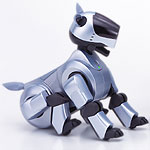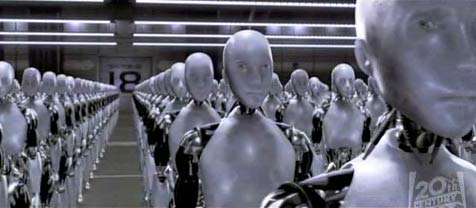|
Does
the future of robotics hold the promise of a dream come true to
lighten the workload on humanity and provide companionship. Or the
murder and mayhem of Hollywood movies?
by Dr Dylan Evans
When the Czech playwright
Karel Capek sat down in 1920 to write a play about
humanoid machines that turn against their creators, he decided to
call his imaginary creations 'robots', from the Czech word for 'slave
labour'. Ever since then, our thinking about robots, whether fictional
or real, has been dominated by the two key ideas in Capek's play.
Firstly, robots are supposed to do the boring and difficult jobs
that humans can't do or don't want to do. Secondly, robots are potentially
dangerous.
These two ideas remain
influential, but not everyone accepts them. The first dissenting
voice was that of the great Russian-American science-fiction writer,
Isaac Asimov, who was born the same year that Capek wrote his notorious
play. In 1940, barely two decades later, while others were still
slavishly reworking Capek's narrative about nasty robots taking
over the world, Asimov was already asking what practical steps humanity
might take to avoid this fate. And instead of assuming that robots
would be confined to boring and dangerous jobs, Asimov imaged a
future in which robots care for our children, and strike up friendships
with us.
From the perspective
of the early twenty-first century, it might seem that Capek was
right and that Asimov was an idealistic dreamer. After all, most
currently-existing robots are confined to doing nasty, boring and
dangerous jobs, right? Wrong. According to the 2003 World Robotics
Survey produced by the United Nations

Robot Arm
over Earth with Sunburst
|
Economic Commission for Europe,
over a third of all the robots in the world are designed not to
spray-paint cars or mow the lawn, but simply to entertain humans.
And the number is rising fast. It is quite possible, then, that
the killer app for robots will turn out to be not the slave labour
envisaged by Capek, but the social companionship imagined by Asimov.

AIBO
|
The most impressive
entertainment robot currently on the market is undoubtedly
the Aibo, a robotic dog produced by Sony. According to Onrobo.com,
a website devoted to home and entertainment robotics, Aibo is the
standard by which all other entertainment robots are measured. Special
software allows each Aibo to learn and develop its own unique personality
as it interacts with its owner. But at over a thousand pounds a
shot, they aren't cheap.
Commercial products
like the Aibo still have some way to go before they have the quasi-human
capacities of 'Robbie', the child-caring robot envisaged by Asimov
in one of his earliest short-stories, but the technology is moving
fast. Scientists around the world are already beginning to develop
the components for more advanced sociable robots, such as emotional
recognition systems and emotional expression systems.
Emotions are vital
to human interaction, so any robot that has to interact naturally
with a human will need to be able to recognise human expressions
of emotion and to express its own emotions in ways that humans can
recognise. One of the pioneers in this area of research (which is
known as 'affective computing') is Cynthia Breazeal, a roboticist
at the Massachusetts Institute of Technology who has built an emotionally-expressive
humanoid head called Kismet. Kismet has moveable eyelids, eyes and
lips which allow him to make a variety of emotional expressions.
When left alone, Kismet looks sad, but when he detects a human face
he smiles, inviting attention. If the carer moves too fast, a look
of fear warns that something is wrong. Human parents who play with
Kismet cannot help but respond sympathetically to these simple forms
of emotional behaviour.
Another emotionally-expressive
robot called WE-4R has been built by Atsuo Takanishi and colleagues
at Waseda University in Japan. Whereas Kismet is limited to facial
expressions and head movements, WE-4R can also move its torso and
wave its arms around to express its emotions.
The gap between science
fiction and science fact is closing, and closing fast. In fact,
the technology is advancing so quickly that some people are already
worried about what will happen when robots become as emotional as
we are. Will they turn against their creators, as Capek predicted?
In the new Hollywood blockbuster, I, Robot (which is loosely based
on an eponymous collection of Asimov's short stories), Will Smith
plays a detective investigating the murder of a famous scientist.
Despite the fail-safe mechanism built into the robots, which prevents
them from harming humans, the detective suspects that the scientist
was killed by a robot. His investigation leads him to discover an
even more serious threat to the human race.
I,
Robot is set in the year 2035, thirty one years in the future.
To get an idea of how advanced robots will be by then, think about
how far videogames have come in the last thirty one years. Back
in 1973, the most advanced videogame was Pong, in which a white
dot representing a tennis ball was batted back and forth across
a black screen. The players moved the bats up and down by turning
the knobs on the game console. By today's standards, the game was
incredibly primitive. That's how today's robots will look to people
in the year 2035.

iRobots
from the film
|
Will those future people
look back at the primitive robots of 2004 and wish they hadn't advanced
any further? If we want to avoid the nightmare scenario of a battle
between humans and robots, we should start thinking about how to
ensure that robots remain safe even when they are more intelligent.
Isaac Asimov suggested that we could make sure robots don't become
dangerous by programming them to follow the following 'Three
Robot Laws':
1. A
robot may not injure a human being or, through inaction, allow a
human
being to come to harm.
2. A
robot must obey orders given it by human beings except where such
orders
would conflict with the First Law.
3.
A robot must protect its own existence as long as such protection
does not
conflict with the First or Second Law.
At first blush, these
three laws might seem like a good way to keep robots in
their place. But to a roboticist they pose more problems than they
solve. Asimov was well aware of this, and many of his short stories
revolve around the contradictions and dilemmas implicit in the three
laws.
The sobering conclusion
that emerges from these stories is that preventing intelligent robots
from harming humans will require something much more complex than
simply programming them to follow the three laws.
Note on the Author:
Dr Dylan Evans teaches robotics at the University of the West of
England, Bristol.
|
